 |
 |
 |
| |
LdT & HBV Therapy Viral Dynamics
|
| |
| |
Reported by Jules Levin
"Viral Dynamics for LdT (Telbivudine)-Treated Chronic Hepatitis B Patients: High Degree of Initial Inhibition with Dose-Dependent 2nd Phase HBV Clearance Suggests a New Model for HBV Dynamics"
A.U. Neumann 1, X.J. Zhou 2, R. Boehme 2, G. Chao 2, C. Fang 2, N. Brown 2, and C.L. Lai 3 1) Bar-Ilan University, Israel, 2) Idenix Pharmaceuticals, Cambridge MA, USA, 3) University of Hong Kong
PROGRAM ABSTRACT
VIRAL DYNAMICS FOR LDT(TELBIVUDINE)-TREATED HEPATITIS B PATIENTS: HIGH DEGREE OF INITIAL INHIBITION WITH DOSE-DEPENDENT SECOND-PHASE HBV CLEARANCE SUGGESTS A NEW MODEL FOR HBV DYNAMICS
Avidan U Neumann, Bar-Ilan University, Ramat-Gan 52900, Israel; Xiao J Zhou, Richard E Boehme, George Chao, Christopher Fang, Nathaniel A Brown, Idenix Pharmaceuticals, Cambridge, MA; Ching L Lai, University of Hong Kong, Hong Kong, Hong Kong Special Administrative Region of China
Background: LdT (telbivudine) is a potent HBV polymerase inhibitor that rapidly suppresses viremia in patients with chronic hepatitis B (CHB) (Lai, AASLD 2001). A mathematical viral dynamics model (Neumann, Science 1998) with one population of infected cells has been used to describe the biphasic decline of HBV viremia during antiviral treatment. Here we report analyses of changes in HBV viremia during a 4-week LdT phase I/II trial, which suggest the presence of additional efficacy mechanisms, not accommodated by the current model, during second-phase HBV decline.
Methods: Viremia in 36 treatment-naïve HBeAg-positive CHB patients was quantified weekly during 4 weeks of treatment and 8 weeks post-treatment in a phase I/II dose escalation study of LdT (25, 50, 100, 200, 400, or 800 mg/day). Serum HBV DNA was quantified by Roche COBAS PCR, and data were fitted to the viral dynamics model. Correlations between parameters were tested with the Spearman non-parametric test; differences between dose groups were tested by Mann-Whitney.
Results: A biphasic decline in HBV viremia, with inflection during the second week, was observed with LdT treatment, as expected. The Week 1 slope (0.66 ± 0.14/day) is consistent with a half-life of free HBV virions of 12-24 hrs, and provides a minimal estimate of LdT effectiveness in blocking production of ε = 98.8% for doses 25-200 mg and 99.4% for doses 400-800 mg (P=NS). Surprisingly, despite the high degree of initial inhibition, second phase decline was clearly dose-dependent with a mean decline of 0.27±0.08 log/wk for doses 25-100 mg and 0.41±0.14 log/wk for doses 200-800 mg (P<0.01). Post-treatment viral relapse was delayed and had slower slope in the 200-800 mg dose groups, compared to the lower doses (P<0.002). A dose dependence for second-phase viral clearance and for post-treatment viral relapse cannot be explained by the current viral dynamics model when initial effectiveness is >= 96%, as was observed with LdT for all dose groups. These observations suggest that, for very potent anti-HBV agents, the viral dynamics model needs to be extended to consider a third functional compartment of latently infected cells, that contribute to a slower second-phase decline unless its activation is highly suppressed by the drug.
Conclusion: HBV decline during LdT treatment is biphasic, with first-phase effectiveness consistently >99% at doses >= 200 mg/day. Contrary to results with previous agents and model predictions, second phase clearance and post-treatment relapse were clearly dose dependent. These results, revealed by the LdT response data, suggest the presence of additional efficacy mechanisms pertaining to an additional functional compartment of infected cells.
|
|
| |
| |
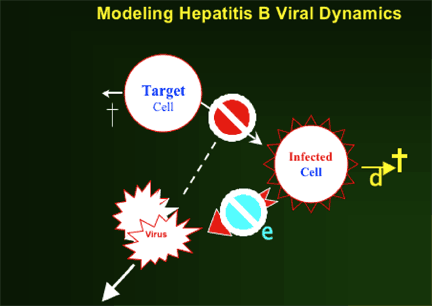 |
|
| |
| |
|
|
| |
| |
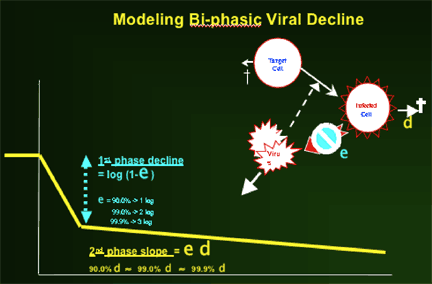 |
|
| |
| |
|
|
| |
| |
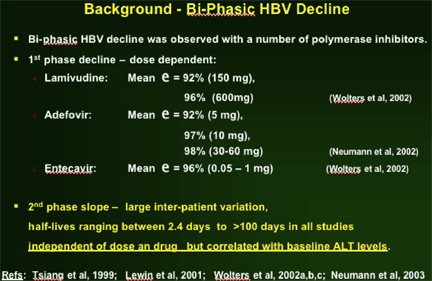 |
|
| |
| |
|
|
| |
| |
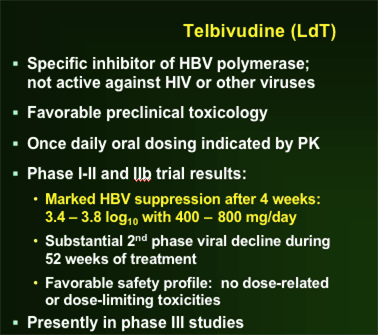 |
|
| |
| |
|
|
| |
| |
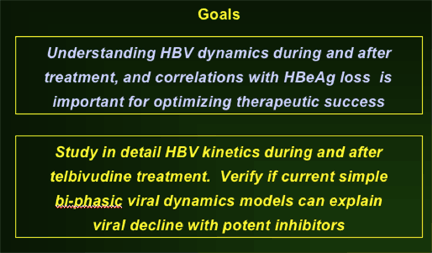 |
|
| |
| |
|
|
| |
| |
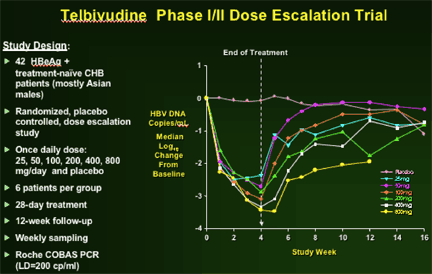 |
|
| |
| |
|
|
| |
| |
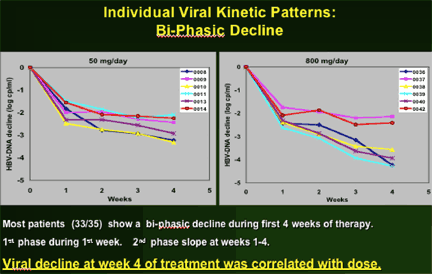 |
|
| |
| |
|
|
| |
| |
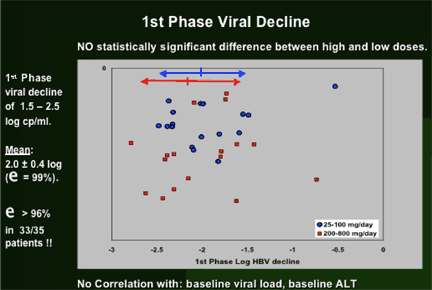 |
|
| |
| |
|
|
| |
| |
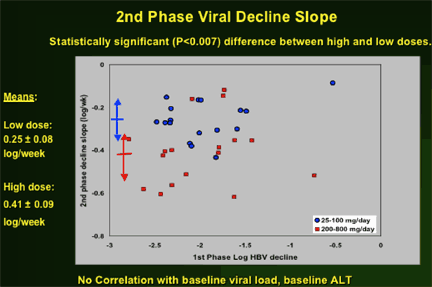 |
|
| |
| |
|
|
| |
| |
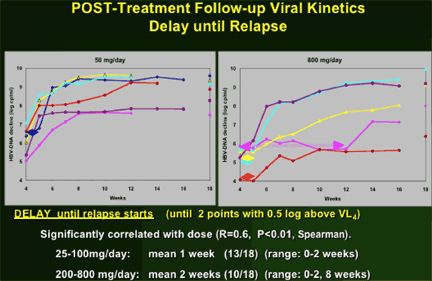 |
|
| |
| |
|
|
| |
| |
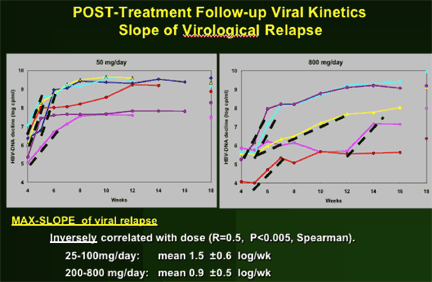 |
|
| |
| |
|
|
| |
| |
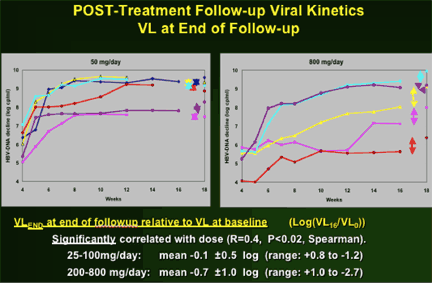 |
|
| |
| |
|
|
| |
| |
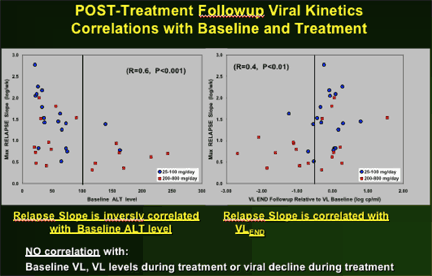 |
|
| |
| |
|
|
| |
| |
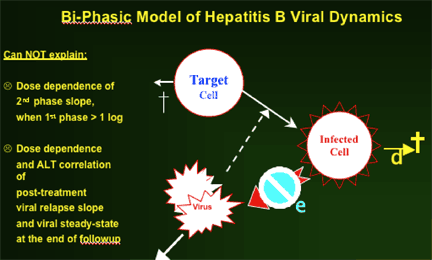 |
|
| |
| |
|
|
| |
| |
 |
|
| |
| |
|
|
| |
| |
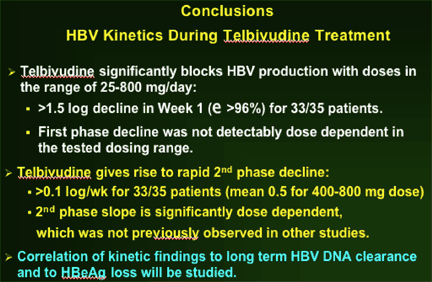 |
|
| |
| |
|
|
| |
| |
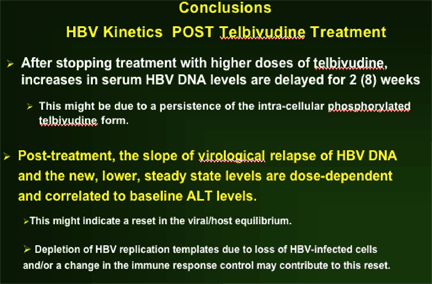 |
|
| |
| |
|
|
| |
| |
 |
|
| |
| |
|
| |
|
 |
 |
|
|